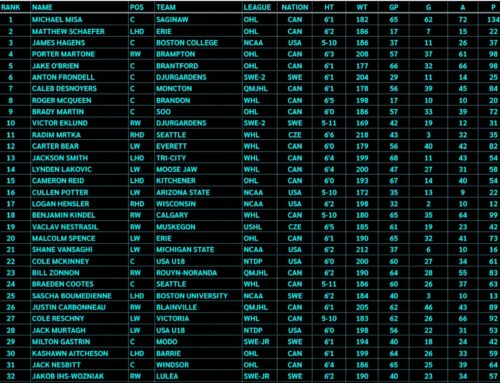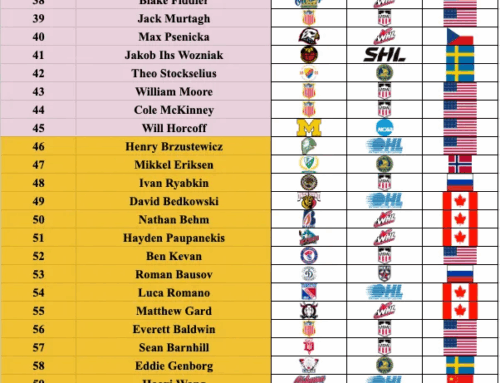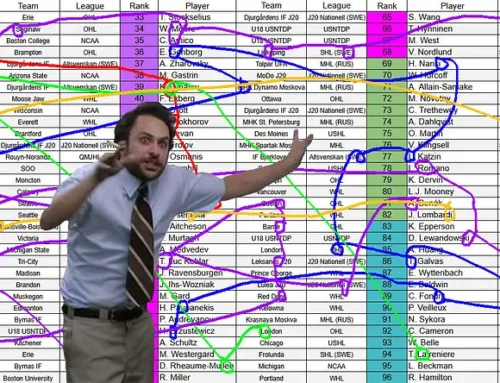Draft Class Deep Dive: RHD Jamie Drysdale
Tony Ferrari
2020-06-30
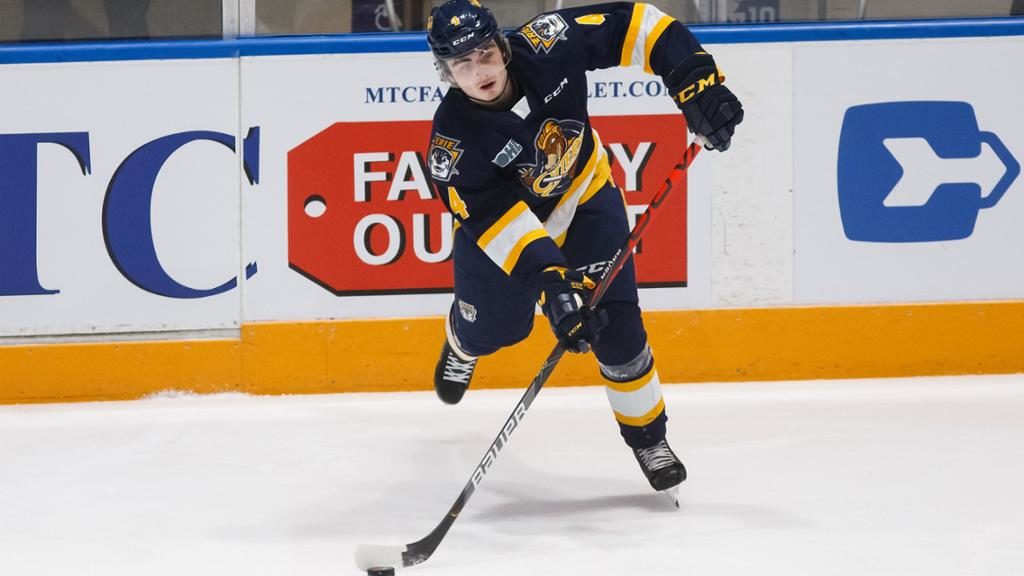
Jamie Drysdale of the Erie Otters, the near-consensus top defender in the 2020 NHL Draft.
Jamie Drysdale has been the near-consensus top defenseman in the 2020 NHL Draft for much of the year. His elite-level skating and transitional play are among the best in the draft class at any position. The draft class isn’t chock-full of defensive talent but there have been a few names that have separated themselves and Drysdale heads that pack. With Jake Sanderson‘s rise in the second half, some have begun to call into question whether Drysdale is truly the clear-cut top dog. Other prospects such as Kaiden Guhle and Braden Schneider have been garnering the attention of mainstream media outlets and players such as Emil Andrae, William Wallinder, and Helge Grans and capturing the attention of analysts across the spectrum. Drysdale seems to be one of the less talked about defenders in the class.
To many, Drysdale has nothing to prove to retain the pole position among defenders. With the lack of a future number one defender in the mold of a Cale Makar, Quinn Hughes, or Miro Heiskanen, the young Erie Otters defender is one of the few that have a real shot at becoming a true top-pair defender. His defensive play lends itself to the modern style of game and where the sport is going and his skating and transitional play allow him to be effective in all situations.
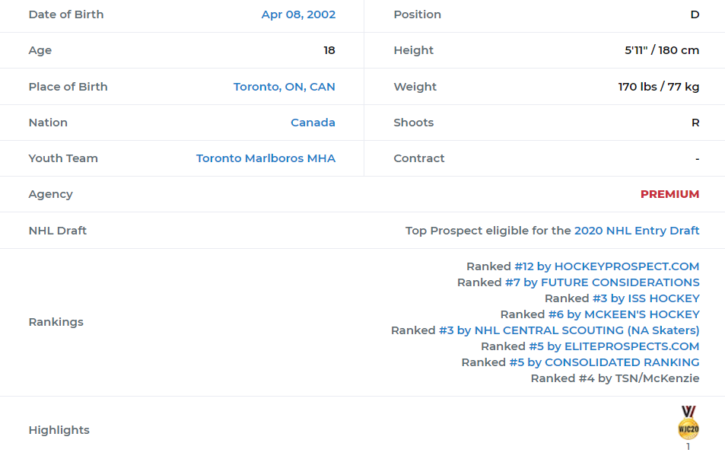
Jamie Drysdale’s Elite Prospects Information
Despite the presence of so many high-end offensive talents up front, the last time a draft featured the first defender coming off the board outside the top-five was 2003 so expecting Drysdale to be selected in the top-five is more than reasonable despite the fact that he may not be the best player available at that point. He was a stud for the Erie Otters all season long and surprised some by making the Canadian World Junior roster as a draft-eligible defenseman. His role there grew as the event went on and the confidence that he earned from that team carried on to the rest of the season. So what is a team getting in Drysdale (jersey #4 for Erie, #6 for Canada) and what role can he play at the next level? Is he the offensive dynamo that some have been led to believe? Is his defensive game a bit of a disaster as some have complained?
Skating and Mobility
One thing that is often said about Drysdale is that he is an elite skater. When you watch the tape, it’s impossible not to notice his mobility in all directions. He has the escapability that teams covet in defenders, especially smaller defenders. He has the agility and edgework to create space for himself in all three zones and the puck handling to do all of it with control of the puck. His stride is technically sound and doesn’t require a lot of effort. He seems fluid and effortless as he maneuvers around the ice.
In the clip above, Drysdale collects the puck at the offensive blueline and makes a bee-line towards the top of the slot. Once he recognizes that the defensive team begins to collapse around him, Drysdale has the sense of mind to use his elusive footwork to work himself into space back towards the blueline. What makes it special is his ability to do so while maintaining his dangerous position. He immediately rotates his body to ensure that the entire offensive zone is in his sights and he can move the puck or take a shot towards the net while altering the angle as he moves laterally.
One area of Drysdale’s skating that does need a bit of improvement is his tendency to be a bit overconfident in his maneuverability. There are times when the shifty defender attempts to skate himself out of trouble and winds up turning the puck over as he gathers speed in the neutral zone, oftentimes leaving him very little room to utilize his skating to get back in the play so often. The video above is an example of this as he attempts to work off the wall with the puck and then up through the middle of the ice. He skates himself out of trouble in his own zone and then is closed in on in the neutral zone. Although this issue is more about his decision making with the puck and over patience, it stems from his general confidence in his skating. Improvement in this area comes easy to smart defenders as they watch their tape, see their mistakes, and make adjustments while they develop. Fixable issues like this need to be identified by scouts in order to relay that information to the team’s development staff.
Offensive Transitions
Many in the scouting community peg Drysdale as an offensive defenseman. While he certainly has offensive ability, the true strength of his game comes in transition – both offensively and defensively. His ability to move the puck up the ice is impressive. His skating and puck skills are key to his transition play. In the clip below, Drysdale can be seen collecting the puck in behind his own net and immediately looking up ice to survey what is in front of him. Identifying that he has space to exit the zone with control, Drysdale builds speed as he drives up the wall. As he encounters the opponent’s neutral zone defensive structure, he is easily able to work his way around the opposition. Entering the offensive zone with control, Drysdale is able to put his tools to good use.
Drysdale shows excellent passing ability when breaking out of the offensive zone. He has a knack for finding passing lanes through traffic in the neutral zone. He leads the pass recipient and helps put them in good position to create space thanks to where Drysdale puts his passes. In the clip below, the Otters defender corrals a pass in his own zone and looks up ice. Identifying a streaking forward, Drysdale finds the attackers tape with a crisp and hard pass, leading his forward into the offensive zone and in on a breakaway.
Drysdale is a consistent puck mover who pushes the pace of play and gets the puck from the defensive zone to offensive zone with efficiency and ease. He finds his teammates with passes all over the ice and his raw passing talent is in the upper echelon of all draft eligibles. His skating is elusive and agile but lacks a truly elite top-speed. As a blueliner who is a technically sound skater and excels in every other aspect when it comes to his mobility, he shouldn’t be hampered too much by a good but not great top gear.
One issue that has reared its head with Drysdale is that he often makes the first play he sees and not always the right one. At times he rushes the play and doesn’t allow it to develop. There are times when he will dump the puck out of the defensive zone when there is a clear pass or he will make a pass up to a winger despite a defender on his back rather than making the lateral pass to his teammate to find a better passing angle. While there weren’t too many times where he went glass-and-out, when he did it seemed like he didn’t need to as he would have space to skate or time to make a pass. Small details like that are what need to be ironed out for Drysdale to remain a transitional force at the next level.
Transitional Defense
This is where Drysdale is among the best defenders in the draft class. While there are concerns when the play is hemmed into his defensive zone, his ability to break-up zone entries and prevent clean entries is special. Drysdale’s footwork is what gives him the ability to close off in the neutral zone and at the blue line effectively. He is among the more aggressive defenders at the blueline, attempting to cut the play down before they even find any footing.
A hostile and preventative approach to defense, Drysdale is persistent in meeting attacking forwards at the blueline to break-up the play. He forces dump in regularly and oftentimes has the ability to poke the puck free and corral the loose puck. In the play below, Drysdale is able to subtly take the puck off the Finnish forward’s stick and then calmly takes the puck down the wall and keeps his head up ice, moving the puck to his defensive partner.
Drysdale’s aggressive approach against transition can lead to some times when he is beat when trying to step up. In junior hockey, he is often able to make up for those mistakes, as he does below, but as he advances to higher levels he will need to choose when to take those aggressive chances a bit more effectively. Developing a bit more defensive awareness will be key into continue to develop his mental game. His offensive hockey sense is very high level but there is work to do in his own end and when preventing the opposition from making clean transitions.
He is excellent at playing the weakside in transition as well. He covers the slot and stays in line with the backside attacker all the way to the net. When the puck is chipped in behind him defensive partner, Drysdale’s ability to read and react is quite strong. He has the ability to get to the loose puck and make a good, smart pass to get the puck to safety as he does below. Identifying how the play is going to develop is a strength of Drysdale’s game and his skating and willingness to join the rush are an asset to a team as they try to break out of their zone cleanly.
In-Zone Defensive Play
With defensemen specifically, top-speed isn’t a necessity. Drysdale is the perfect example of why that’s true. His edgework is high end and his agility are very good. He is able to shadow attackers in the offensive zone and stay square to the shooter to ensure that he is in a good position to use his quick stick to poke the puck free and gain control to turn the puck up ice. In the clip below, Drysdale is the aggressor in the physical confrontation but is clearly a bit underpowered and the puck is retained by the Finns. He rolls off the altercation and recedes defensively to regain position inside position. As the puck is moved down the wall, Drysdale is able to stop and start, shadowing the forward before stripping him of the puck. He skates behind his own net and then calmly turns the play back for his teammates.
An area that Drysdale really lacks behind in is defending the net front and being able to assert himself physically when the play calls for it. His net-front defense is lackadaisical. He often seems uninterested in even attempting to clear the net-front or battle for stick positioning. He often allows too clean of a route to the net and doesn’t really seem to pay attention when his goaltender is being crowded and screened. In the play below, Drysdale shows his physical limitations in a failed battle in the corner, and then when he retreats to his net, he shows little willingness to get involved in the battle for the puck.
He does show an understanding of the passing lanes and how to ensure that his stick and body are in the proper position. Below we see an example of that with Drysdale getting his body and stick in the way, preventing passing lanes from developing but again seems to lack the ability to do much in front of the net. While the net-front issue can be fixed with added strength, Drysdale will also have to commit to putting in the effort there as it seems to be one of the few areas that disinterest’s the young Canadian World Junior gold medalist. Physicality will likely never be his strong suit, but Drysdale’s game would mesh well with a good, stout defensive blueliner because of his ability to move the puck and play in the offensive zone.
The Erie rearguard is an average in-zone defender at best playing in the OHL. He has a 57.5% Challenge rate (one-on-one battles percentage), lagging behind many defenders in this draft class such as Kaiden Guhle (60.4%), Braden Schnieder (59.5%) and Jake Sanderson (66.3%). When looking at where he is losing battles the most, board play and net-front consistently come up. His clear strength is defending in open ice thanks to his mobility and intelligent stick.
Offensive Prowess
Jamie Drysdale is a good offensive player. His ceiling is quite high but it is limited by his tendency to do most of his damage from the blueline. He is a skilled playmaker from the backend, showing true quarterback ability but lacks the predatory instinct to attack the high danger areas. He is a volume shooter from the point, attempting a great deal of shots from the low-danger area. In the shooting chart below, we can see that while the shot chart does indicate that Drysdale is shooting a lot, there is a clear void from the slot. He does creep into the faceoff circle, the bulk of Drysdale’s shooting comes from the outside.
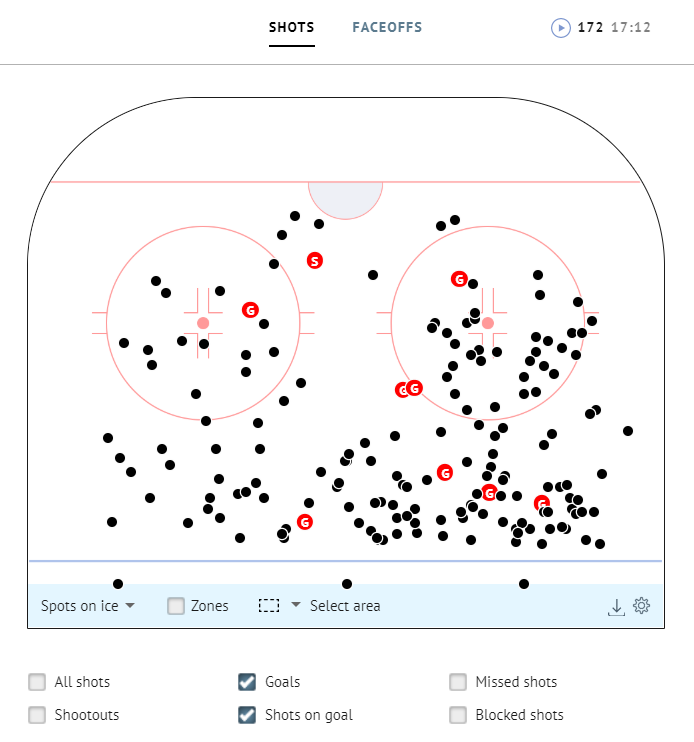
Jamie Drysdale Shot Map courtesy of InStat Hockey
While he doesn’t shoot from high danger areas often, when he does he has an extremely effective shot. He locates it well and has a good snap shot. In the video below, Drysdale takes advantage of the fact that he isn’t being aggressively defended and he takes the ice given to him. He makes a good move when the defender does attempt to step up. Due to his aggressiveness, he is able to get a good shot away and score.
His aforementioned passing acumen is equally effective in the offensive zone. With a pass completion percentage of 85%, he has true quarterbacking ability. He uses his eyes to look off defenders and manipulate their positioning. Much like the best NFL quarterbacks look off defensive backs by fainting one way while being fully aware of the fact that they want to pass to a different receiver, Drysdale is able to influence the defense into opening up passing lanes for him to exploit. Drysdale gets an assist in the following clip but it’s his eyes that warrant attention. Despite looking to the right side of the ice and even squaring his shoulders off that way, he is able to pass to the left to set up an easy one-timer.
The manipulation doesn’t end there. He is also able to draw defenders towards him and seemingly pull the entire defensive unit with him when he utilizes his lateral mobility at the blueline. Misdirection is key to Drysdale’s offensive game. As seen below, Drysdale collects the pass off the faceoff and immediately starts to the left on the blueline. The defense follows him and then he passes back against the grain for a good shot that is redirected into the net. Drysdale’s ability to pull everyone with him boils down to his mobility.
He is aggressive down the wall in the offensive zone and can get burned at times when he is pinching to try and sustain pressure. He oftentimes fires the puck in deep rather than making a play with it. This seems to be the result of him making the first play he sees rather than the right one again.
Special Teams
The fact of the matter is that Drysdale has a real shot at becoming a good powerplay quarterback who can excel in transition. His ability to manipulate defenses should allow him to play on the top powerplay unit at the NHL level one day. He lacks the predatory instinct to do the kind of dynamic things that we see from young defenders at the NHL level such as Cale Makar and Quinn Hughes but the ability to be the primary facilitator at the blueline is there thanks to his excellent skating and mobility.
Above, Drysdale shows off his ability as a skater and a facilitator on the powerplay. His value comes in transporting the puck through his skating and passing as well as his ability to make good passes from the blueline to move the puck on the powerplay. He is a skilled passer who finds the smallest of windows and feather passes through. His ability to make passes both on the move, regardless of direction, helps make him a dangerous attacker on the powerplay any time the puck is on his stick.
His penalty killing is average at best. He is able to use his skating to shadow attacking players and his stick check is quick and controlled. His lack of strength and his inefficiencies, when hemmed in his own zone, will limit him at the next level, especially if strength continues to be an issue as an undersized defenseman. He will likely be able to utilize his intelligence and skating to at least play on a second penalty kill unit but there is a world where Drysdale is non-existent on the penalty kill at the NHL level.
Best in Class
The evidence for Drysdale being the top defensemen is there. In terms of raw statistics, he was among the best draft-eligible defenders. His 0.95 points-per-game were tops among CHL defenders eligible for the draft for the first time and he performed admirably at the World Junior Championships for Team Canada. He earned more ice-time as the tournament went on and showed flashes of why he will be darkhorse for consideration for the best defenseman at the tournament next year.
There are some real questions in his game from his questionable in-zone defensive play to his lack of strength and size. There is also a seemingly intentional hesitation to really penetrate the offensive zone as a shooter. Drysdale understands his strengths are as a distributor offensively from the blue line and on the half wall. He knows that his passing is the elite trait for driving offense. His shooting talent is good but a lack of that predatory gene may be the only real limiting factor offensively.
The 2020 NHL Draft is not the strongest on the backend. There may not be a true number one defender in this group but Drysdale is the closest thing to it. He projects as a top-pairing defender but likely requires a defensive foil as a partner. He will be the offensive driver from the back end and excel when moving the puck up the ice. Despite the reality that he may not be a Norris-level defender in his career, Drysdale is going to be a valuable transitional defender who is best when preventing the opposition from entering the offensive zone cleanly and then pushing play up the ice seemingly instantaneously.
*******
Thank you for joining us for the latest Deep Dive for the 2020 NHL Draft. Shot chart and statistics such as passing percentage and challenge rate courtesy of InStat Hockey, a top of the line video and scouting platform. For more from InStat, follow them on Twitter. For more on prospects and the NHL Draft, you can follow Tony Ferrari on Twitter.
For your fantasy hockey needs, the DobberProspects Fantasy Prospect Report and Fantasy Guide are the best sources to get you ahead of the game in your league whether you play in a simple year-to-year league or you’re involved in a decade long keeper league, the DobberProspects’ Fantasy Guides are your one-stop-shop for winning your league!



